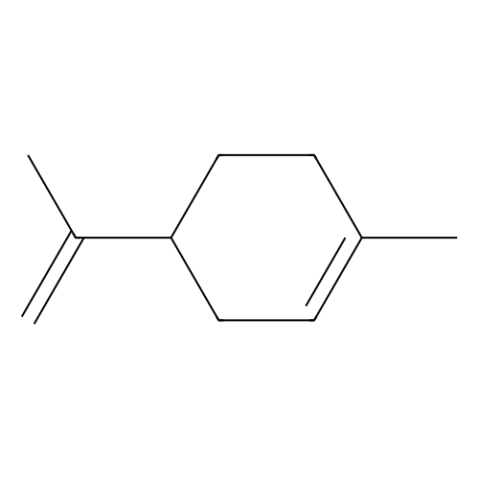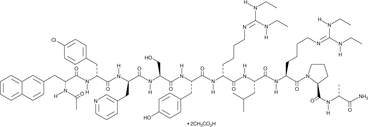Allergy
Products for Allergy
- Cat.No. Product Name Information
-
GC40802
(±)12(13)-DiHOME
Isoleukotoxin diol
(±)12(13)-DiHOME is the diol form of (±)12(13)-EpOME, a cytochrome P450-derived epoxide of linoleic acid also known as isoleukotoxin.

-
GC40801
(±)9(10)-DiHOME
Leukotoxin diol
Leukotoxin is the 9(10) epoxide of linoleic acid, generated by neutrophils during the oxidative burst.
-
GC41346
(+)-Cedrol
(+)-Cedrol is a sesquiterpene alcohol that has been used in Cannabis testing and has diverse biological activities.

-
GC20028
(±)12(13)-DiHOME MaxSpec® Standard
Isoleukotoxin diol

-
GC49294
1-(4-Chlorobenzhydryl)piperazine
N-(p-Chlorobenzhydryl)-piperazine, Norchlorcyclizine, NSC 86164
An inactive metabolite of meclizine and chlorcyclizine
-
GC41998
1-Methyl-4-imidazoleacetic Acid (hydrochloride)
Methylimidazoleacetic Acid, MIMA, MIAA
1-Methyl-4-imidazoleacetic acid (MIMA) is a stable metabolite of histamine that is produced by the oxidation of the primary metabolite, N-methylhistamine.
-
GC18637
11β-Prostaglandin F2α
9α,11βPGF2α, 11βPGF2α, 11epi PGF2α
11β-Prostaglandin F2α (11β-PGF2α) is the primary plasma metabolite of PGD2 in vivo.

-
GC40451
15(S)-HETE
15(S)-Hydroxyeicosatetraenoic Acid
15(S)-HETE is a major arachidonic acid metabolite from the 15-lipoxygenase pathway.
-
GC42251
3-Bromotyrosine (trifluoroacetate salt)
3-bromo-Tyr
3-Bromotyrosine is a product of protein oxidation found after activation of eosinophils during an allergic response.
-
GC42252
3-Bromotyrosine-13C9,15N (trifluoroacetate salt)
3-bromo-Tyr-13C9,15N
3-Bromotyrosine-13C9,15N is intended for use as an internal standard for the quantification of 3-bromotyrosine by GC- or LC-MS.
-
GC42275
3-hydroxy Desloratidine
SCH 45581
3-hydroxy Desloratidine is a major metabolite of desloratadine , a tricyclic antagonist of the histamine H1 receptor.
-
GC40692
3-Propylxanthine
D 4028, Enprofylline
3-Propylxanthine acts as a selective and competitive A2B receptor antagonist with the Ki of 7 μM.
-
GC49676
6β-hydroxy Budesonide
A metabolite of budesonide

-
GC46753
9(S),12(S),13(S)-TriHOME
(-)-Pinellic Acid, 9S,12S,13S-Pinellic Acid
An oxylipin
-
GC49309
A-943931 (hydrochloride hydrate)
A histamine H4 receptor antagonist

-
GC40638
Alclometasone Dipropionate
ACM, Alclometasone 17,21-Dipropionate, SCH 22219
Alclometasone dipropionate (ACM) is a corticosteroid.
-
GC42824
APC 366 (trifluoroacetate salt)
APC 366 is a mast cell tryptase inhibitor (Ki = 7.1 μM for human recombinant enzyme).

-
GC49057
Azelastine-13C-d3 (hydrochloride)
An internal standard for the quantification of azelastine

-
GC42897
BAY 61-3606 (hydrochloride)
BAY 61-3606 is a cell-permeable, reversible inhibitor of spleen tyrosine kinase (Syk; Ki = 7.5 nM; IC50 = 10 nM).

-
GC20142
Beta-Sitosterol
β-Sitosterol (purity>98%); 22,23-Dihydrostigmasterol (purity>98%))
Beta-Sitosterol is a plant sterol with multiple biological activities, including anti-inflammatory, anti-tumor, antipyretic and immunomodulatory activities.
-
GC46922
Betamethasone 21-phosphate (sodium salt hydrate)
A synthetic glucocorticoid

-
GC49724
BIO-1211 (trifluoroacetate salt)
A peptide inhibitor of α4β1 integrin

-
GC46024
Bromodiphenhydramine (hydrochloride)
Bromazine, NSC 36113
A histamine H1 receptor antagonist
-
GC46956
Budesonide-d8
An internal standard for the quantification of budesonide

-
GC19432
BXL-628
Elocalcitol, Ro 26-9228
BXL-628 (BXL-628) is a selective, orally active vitamin D receptor (VDR) agonist.
-
GC43052
C18 Phytoceramide (t18:0/18:0)
Cer(t18:0/18:0), Ceramide (t18:0/18:0), N-Octadecanoyl Phytosphingosine, C18:0 Phytoceramide, SPS, N-Stearoyl Phytosphingosine
C18 Phytoceramide (t18:0/18:0) (Cer(t18:0/18:0)) is a bioactive sphingolipid found in S.
-
GC40141
C18 Phytoceramide-d3 (t18:0/18:0-d3)
Cer(t18:0/18:0) - d3, Ceramide (t18:0/18:0)- d3, N-Octadecanoyl Phytosphingosine- d3, C18:0 Phytoceramide- d3, N-Stearoyl Phytosphingosine- d3
C18 Phytoceramide-d3 (t18:0/18:0-d3) is intended for use as an internal standard for the quantification of C18 phytoceramide (t18:0/18:0) by GC- or LC-MS.
-
GC43129
CALP1 (trifluoroacetate salt)
Calcium-like Peptide 1
CALP1 is an 8-residue calcium-like peptide that interacts with an EF hand motif based on the troponin C superfamily calcium binding site.
-
GC49433
Capsiate
A capsaicin analog with diverse biological activities

-
GC49197
Carbinoxamine-d6 (maleate)
An internal standard for the quantification of carbinoxamine

-
GC47040
Carebastine-d5
An internal standard for the quantification of carebastine

-
GC52016
Cetirizine N-oxide
An oxidative degradation product of cetirizine

-
GC49652
Chlorpheniramine-d6 (maleate)
(±)-Chlorpheniramine-d6, Chlorprophenpyridamine-d6
An internal standard for the quantification of chlorpheniramine
-
GC45409
Ciclesonide-d7
CIC-d7

-
GC49082
Cicloprofen
(±)-Cicloprofen, α-Methylfluorene-2-acetic Acid, NSC 293916, SQ 20,824
An NSAID
-
GC43325
Cromolyn (sodium salt hydrate)
Cromolyn is a chromone complex that acts as a mast cell stabilizer, preventing the release of histamine.

-
GC47138
Cyclizine (hydrochloride)
A histamine H1 receptor antagonist

-
GC43395
Deethylindanomycin
A 83094A, 16-Deethylindanomycin, Omomycin
Deethylindanomycin is a polyether antibiotic that has been found in S.
-
GC47196
Desloratadine-d4
Descarboethoxyloratadine-d4
A neuropeptide with diverse biological activities
-
GC40867
Diflorasone Diacetate
U-34865
Diflorasone is a corticosteroid with anti-inflammatory activity.
-
GC43459
Dihydro Montelukast
Dihydro montelukast is a potential impurity found in commercial montelukast preparations.

-
GC47234
Diosmetin-d3
Diosmetol-d3, Luteolin 4'-methyl ester-d3
An internal standard for the quantification of diosmetin
-
GC26335
Dipentene
LIMONENE; Dipentene; Cinene; Cajeputene; DL-Limonene; Kautschin; Dipenten; Eulimen; Nesol; p-Mentha-1,8-diene; 1,8-p-Menthadiene; Cajeputen; Limonen; Cinen; Inactive limonene; Acintene DP dipentene; 1-Methyl-4-(1-methylethenyl)cyclohexene; Cyclo

-
GC47257
Dodecanoyl D-Sucrose
Sucrose monolaurate
A nonionic surfactant
-
GC47278
Ebastine-d5
An internal standard for the quantification of ebastine

-
GC49063
Emedastine-13C-d3 (fumarate)
An internal standard for the quantification of emedastine

-
GC48856
Fenspiride-d5
Decaspiride-d5
An internal standard for the quantification of fenspiride
-
GC47347
Fexofenadine-d10 (hydrochloride)
MDL-16455-d10 hydrochloride; Terfenadine carboxylate-d10 hydrochloride
An internal standard for the quantification of fexofenadine
-
GC45455
Fluticasone 17β-Carboxylic Acid

-
GC47368
Formoterol (hemifumarate hydrate)
A neuropeptide with diverse biological activities

-
GC43697
Formoterol O-β-D-Glucuronide
Formoterol O-β-D-glucuronide is a metabolite of formoterol .

-
GC47369
Formoterol-13C-d3 (hemifumarate)
A neuropeptide with diverse biological activities

-
GC49089
FR900359
UBO-QIC
FR900359 is an inhibitor of G proteins Gαq, Gα11, and Gα14 with IC50 values of 13.18, 10.47, and 10nM, respectively and is isolated from the leaves of the ornamental plant Ardisia crenata
-
GC49420
Gallic Acid-d2
3,4,5-Trihydroxybenzoic Acid-d2
An internal standard for the quantification of gallic acid
-
GC43736
Ganirelix (acetate)
Ganirelix is a gonadotropin-releasing hormone receptor (GNRHR) antagonist (IC50 = 3.6 nM; pA2 = 9.3).

-
GC47400
GGTI 2133 (trifluoroacetate salt)
A geranylgeranyl transferase I inhibitor

-
GC60183
GSK2245035
A TLR7 agonist

-
GC43802
HA-1004 (hydrochloride)
HA-1004 is an inhibitor of protein kinase G (PKG) and PKA (Kis = 1.4 and 2.3 μM, respectively).

-
GC45801
Hesperetin-13C-d3
A neuropeptide with diverse biological activities

-
GC52043
Hydrocortisone Aceponate
Hydrocortisone 17-Propionate 21-Acetate
Hydrocortisone aceponate (Hydrocortisone 17-propionate 21-acetate) is a potent topical glucocorticoid.
-
GC43879
Hydroxy Ebastine
Hydroxy Ebastine is an ebastine metabolite.

-
GC47448
Hydroxyzine-d8 (hydrochloride)
Hydroxyzine-d8 (dihydrochloride) is the deuterium labeled Hydroxyzine dihydrochloride.

-
GC49343
Isoproterenol-d7 (hydrochloride)
Isoprenaline-d7
An internal standard for the quantification of isoproterenol
-
GC91148
JAK Inhibitor 31
A JAK2 inhibitor

-
GC47529
Ketotifen-13C-d3
A neuropeptide with diverse biological activities

-
GC48340
Kinetensin (human) (trifluoroacetate salt)
IARRHPYFL, Ile-Ala-Arg-Arg-His-Pro-Tyr-Phe-Leu

-
GC52283
L-Cysteine-15N-d3
L-Cys-15N-d3, L-(+)-Cysteine-15N-d3, (R)-Cysteine-15N-d3
An internal standard for the quantification of L-cysteine
-
GC44054
Leukotriene C4 methyl ester
LTC4 methyl ester
Leukotriene C4 (LTC4) is the parent cysteinyl-leukotriene produced by the LTC4 synthase-catalyzed conjugation of glutathione to LTA4.
-
GC47558
Leukotriene C4-d5 methyl ester
LTC4d5 methyl ester
A neuropeptide with diverse biological activities
-
GC44055
Leukotriene D4 methyl ester
Leukotriene D4 (LTD4) is one of the constituents of slow-reacting substance of anaphylaxis (SRS-A) produced by the metabolism of LTC4 by γ-glutamyl transpeptidase.

-
GC47559
Leukotriene D4-d5
LTD4d5
A quantitative analytical standard guaranteed to meet MaxSpec® identity, purity, stability, and concentration specifications
-
GC44056
Leukotriene E4 methyl ester
LTE4 methyl ester
Leukotriene E4 (LTE4) is produced by the action of a dipeptidase on LTD4 leaving only the cysteinyl group still attached to the fatty acid backbone.
-
GC47560
Leukotriene E4-d5
LTE4-d5
A quantitative analytical standard guaranteed to meet MaxSpec® identity, purity, stability, and concentration specifications
-
GC52074
Loratadine N-oxide
SCH 38554
Loratadine n-oxide is a metabolite of Loratadine.
-
GC47574
Loratadine-d4
Loratidine-d4; SCH 29851-d4
A neuropeptide with diverse biological activities
-
GC47575
Loratadine-d5
An internal standard for the quantification of loratadine

-
GC47601
Mastoparan (trifluoroacetate salt)
A neuropeptide with diverse biological activities

-
GC10929
Mastoparan X
G protein activator peptide

-
GC49755
Meclizine N-oxide
Meclozine N-oxide
A metabolite of meclizine
-
GC47616
Meclizine-d8 (hydrochloride)
Meclozine-d8
An internal standard for the quantification of meclizine
-
GC48805
Methapyrilene (hydrochloride)
An H1 receptor antagonist and non-genotoxic carcinogen

-
GC52088
Methylchloroisothiazolinone (hydrochloride)
CMIT, MCI, MCIT
A biocide

-
GC47698
Mometasone
(+)-Mometasone
A synthetic glucocorticoid with anti-inflammatory and anti-allergic activities
-
GC52105
Montelukast
MK-476
Montelukast (MK0476 free base) is a potent, selective and orally active antagonist of cysteinyl leukotriene receptor 1 (CysLT1).
-
GC47701
Montelukast-d6 (sodium salt)
MK-476-d6
A neuropeptide with diverse biological activities
-
GC52045
N-desmethyl Azelastine
DAZ, Desmethylazelastine
N-desmethyl Azelastine is a main active metabolite of Azelastine that is oxidatively metabolized by the cytochrome P450 enzyme system with a protein binding rate of 97% and an elimination half-life of 54 hours.
-
GC52173
N-desmethyl-Doxylamine (succinate)

-
GC49138
Naphazoline-d4 (hydrochloride)
2-(1-Naphthylmethyl)-2-imidazoline-d4
An internal standard for the quantification of naphazoline
-
GC91911
Napirimus
Napirimus is an immunosuppressant.

-
GC44375
Neuromedin C (trifluoroacetate salt)
GRP(18-27), NMC
Neuromedin C is a bombesin-like neuropeptide that stimulates uterine smooth muscle contraction and the release of gastrin, somatostatin, and amylase in rats.
-
GC44382
Neuropeptide Y (1-24) (human, rat) (trifluoroacetate salt)
NPY (1-24) (human, rat)
Neuropeptide Y (NPY) (1-24) is an N-terminal fragment of NPY, a neuropeptide involved in controlling appetite, blood pressure, cardiac contractility, and intestinal secretion.
-
GC46191
Oclacitinib-13C-d3
A neuropeptide with diverse biological activities

-
GC47825
Olopatadine-d3 (hydrochloride)
An internal standard for the quantification of olopatadine

-
GC48405
Osanetant (hydrate)
SR 142801
An NK3 receptor antagonist
-
GC44540
PAF C-16 Carboxylic Acid
CPAGP, Plateletactivating Factor C16 Carboxylic Acid
PAF C-16 is a naturally occurring phospholipid produced upon stimulation through two distinct pathways known as the "remodeling" and 'de novo' pathways.
-
GC47855
PAF C-16-d4
Plateletactivating Factor C16d4
An internal standard for the quantification of PAF C16
-
GC44541
PAF C-18
PAF C-18 is a naturally occurring phospholipid produced upon stimulation through two distinct pathways known as the "remodeling" and 'de novo' pathways.

-
GC47856
PAF C-18-d4
A neuropeptide with diverse biological activities

-
GC40159
PAR1 (1-6) (mouse, rat) (trifluoroacetate salt)
H-Ser-Phe-Phe-Leu-Arg-Asn, PAR1-AP, Proteinase-Activated Receptor 1, SFFLRN, TRAP, Thrombin Receptor Activating Peptide
PAR1 (1-6) is a hexapeptide that corresponds to amino acid residues 1-6 of the amino terminal tethered ligand sequence of mouse and rat proteinase-activated receptor 1 (PAR1), residues 42-47 of the full-length mouse sequence, and residues 46-51 of the full-length rat sequence.
-
GC47942
PGDM-d4
Prostaglandin D Metabolited4
A neuropeptide with diverse biological activities



